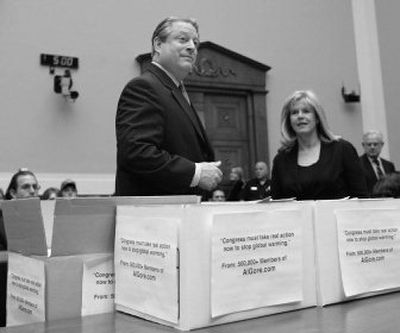Gore comes to Capitol Hill to urge action on warming

WASHINGTON – Environmental activist and former Vice President Al Gore descended on Capitol Hill on Wednesday, telling two congressional panels that global climate change represents the most dangerous crisis in American history and that the measures needed to fix the problem – like an immediate freeze on new emissions from cars and power plants – are far more drastic than anything currently on the table.
Gore, whose documentary “An Inconvenient Truth” won an Academy Award last month, testified before both House and Senate committees in an appearance that drew international media attention.
In both hearings, he had testy exchanges with lawmakers who doubted his scientific evidence or the feasibility of his solutions. Much of his day, though, was spent basking in an odd spotlight: Gore and his cause now have Washington’s full attention. But his message, of a feverish planet and dwindling time in which to cure it, made for a grim homecoming.
“This is not a normal time. We are facing a planetary emergency,” Gore said in the afternoon Senate hearing. “I’m fully aware that that phrase sounds shrill to many people’s ears. But it is accurate.”
Gore, who served a combined 16 years in the House and Senate before becoming vice president in 1992, had not made such a public appearance on Capitol Hill since he lost the 2000 presidential election.
In both hearings, Gore took criticism from Republican lawmakers. The toughest sparring was with Sen. James Inhofe, R-Okla., who has said he believes climate change is a hoax.
Inhofe criticized Gore for using too much energy in his own home in Tennessee, and he also listed a number of scientists who he said had broken with Gore about the reality – or the danger – of warming temperatures.
“Are they all wrong, and you’re right?” he asked.
Outside of those exchanges, many legislators greeted Gore warmly. Gore was hailed as the country’s loudest voice on climate change, the instigator of a movement now gaining momentum around the country and in Washington.
“You have acted for us,” said Sen. Barbara Boxer, D-Calif., the Senate committee chair. “You have acted more than anyone else.”
In his talk, Gore described briefly the scientific consensus on climate change’s causes. Scientists say emissions of “greenhouse gases,” primarily carbon dioxide emitted by cars and power plants burning fossil fuels, are accumulating in the atmosphere at an unsustainable rate and trapping more of the sun’s heat.
A United Nations report in February concluded it was “very likely” that man-made gases were behind most of the increase in global temperatures over the last 50 years.
Gore told the panels Wednesday that these temperature increases could cause polar ice to melt, sea levels to rise, and increase the likelihood of droughts, wildfires and intense hurricanes. Seeking a metaphor to describe the scale of the problem, he listed several pivotal events in American and world history – World War II, the Marshall Plan, the Cold War – and the battle of Thermopylae, in 480 B.C.
Gore’s solutions were as sweeping as his metaphors. His recommendations began with the immediate national freeze on new carbon-dioxide emissions – which could affect everything from cars to lawn mowers to coal-fired power plants – and included an overhaul of the tax code. Payroll taxes should go down, Gore said, and taxes on polluters, especially those who emit carbon dioxide, should go up.
Beyond that, Gore recommended a ban on incandescent light bulbs, which activists say are far less energy-efficient than new compact fluorescent bulbs, raising the fuel-efficiency standards for cars, and a “carbon-neutral mortgage association.” The last would allow homeowners to more easily finance renovations to improve energy efficiency, he said.